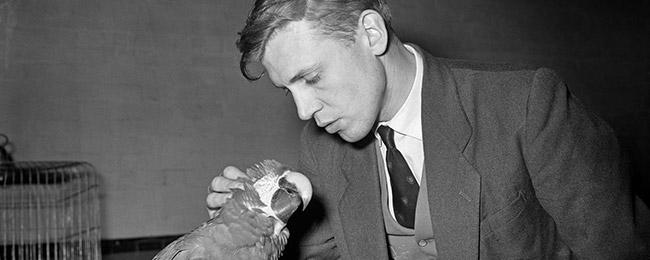Attenborough went to the Wyggeston Grammar School for Boys in Leicester. He attended Clare College, Cambridge, where he studied geology and zoology, obtaining a degree in natural sciences in 1947. Attenborough then performed his National Service in the Royal Navy, spending two years in Wales and the Firth of Forth. He married Jane Elizabeth Oriel in 1950. Their marriage lasted until she died in 1997. They had two children.
Upon leaving the Royal Navy, Attenborough edited children’s science textbooks before applying with the BBC as a radio producer. His application caught the attention of the head of the factual broadcasting television department at the BBC. Television in 1950 was a new technology and few people, Attenborough included, owned a television set. In fact, Attenborough had seen only one television program yet he accepted an offer to train for a career in television. In 1952 he joined the BBC fulltime as a producer.
Attenborough’s first natural history program was the series “The Pattern of Animals.” Hosted by Sir Julian Huxley, it featured animals from the London Zoo, discussed their habitats, courtship rituals and camouflage. The curator of the zoo’s reptile collection Jack Lester worked on the series and the pair created a new show about an animal collecting expedition, “Zoo Quest,” which aired in 1954. In 1957 in Bristol Attenborough created the Travel and Exploration Unit in the BBC, in which he created new documentaries, such as “Traveler’s Tales.” In the early 1960s Attenborough left the BBC to obtain a graduate degree in anthropology. Before finishing, he returned to the BBC as one of its controllers in 1965, with the stipulation that he still make documentaries. Later that year he filmed elephants in Tanzania. In 1971 he joined the first Western expedition to a remote highland in New Guinea to film an unknown tribe for the first time.
One of Attenborough’s outstanding executive decisions was ordering “Civilization,” a history of western art. This series set the future standard for similar programs, including “The Ascent of Man” and “America.” He became the programming director for the BBC in 1969, responsible for the output of all BBC channels. Unhappy in this role, Attenborough returned to programming in 1972. His trip to Indonesia with a film crew resulted in the 1973 series “Eastward with Attenborough.” Further works included the “Tribal Eye,” “Fabulous Animals,” “The Explorers” and the “Life on Earth” series. “Life on Earth” became the benchmark against which natural history films would be judged. The success of “Life on Earth” prompted the BBC to make more ambitious series, such as “The Living Planet” and “The Trials of Life.” Throughout the 1990s, Attenborough produced “Life in the Freezer,” about life in the Antarctic, and “The Private Life of Plants.” An ornithologist employed by the BBC prompted his 1998 series “The Life of Birds.” By the early 2000s, Attenborough produced documentaries covering nearly every form of life. He created a DVD encyclopedia of his natural history documentaries called “Life on Land.” In 2010, Attenborough announced his plan for a new series dealing with the evolutionary history of life on Earth.



